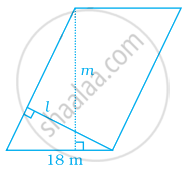Advertisements
Advertisements
प्रश्न
In the given figure, area of ∆AFB is equal to the area of parallelogram ABCD. If altitude EF is 16 cm long, find the altitude of the parallelogram to the base AB of length 10 cm. What is the area of ∆DAO, where O is the midpoint of DC?
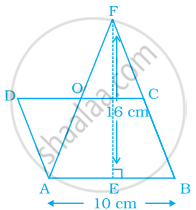
उत्तर
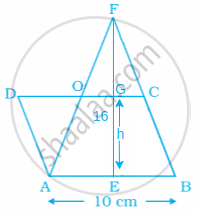
Given, Area of ΔAFB = Area of parallelogram ABCD
⇒ `1/2` × AB × EF = CD × (Corresponding height) ......`[(∵ "area of triangle" = "base" xx "height and area of"),("parallelogram" = "base" xx "corresponding height")]`
⇒ `1/2` × AB × EF = CD × EG
Let the corresponding height be h.
Then, `1/2` × 10 × 6 = 10 × h ......[∵ altitude, EF = 16 cm and base, AB = 10 cm, given] [∵ AB = CD]
⇒ h = 8 cm
In ΔDAO, DO = 5 cm .....[∵ O is the mid-point of CD]
∴ Area of ΔDAO = `1/2` × OD × h
= `1/2 xx 5 xx 8`
= 20 cm2
APPEARS IN
संबंधित प्रश्न
Find the area of the following parallelogram:
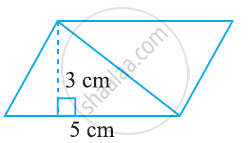
Find the area of the following parallelogram:
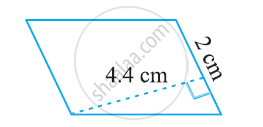
Find the missing value:
| Base | Height | Area of parallelogram |
| 20 cm | ______ | 246 cm2 |
Find the missing values.
| Base | Height | Area |
| 18 cm | 5 cm |
The area of parallelogram whose base 10 m and height 7 m is
The height of the parallelogram is one-fourth of its base. If the area of the parallelogram is 676 sq.cm, find the height and the base
The area of the parallelogram ABCD is 1470 sq.cm. If AB = 49 cm and AD = 35 cm then, find the height, DF and BE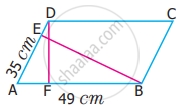
Find the height of the parallelogram whose base is four times the height and whose area is 576 sq.cm
If the sides of a parallelogram are increased to twice its original lengths, how much will the perimeter of the new parallelogram?
Perimeter of a parallelogram shaped land is 96 m and its area is 270 square metres. If one of the sides of this parallelogram is 18 m, find the length of the other side. Also, find the lengths of altitudes l and m in the given figure.
